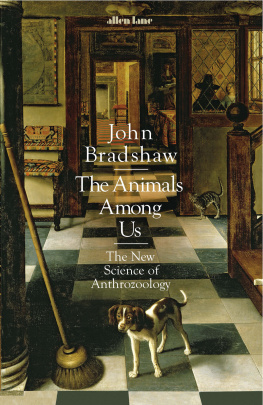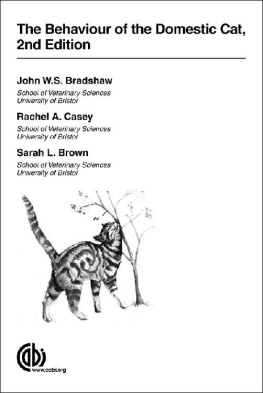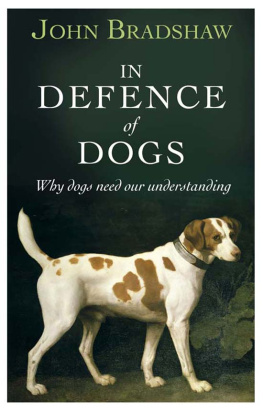John Bradshaw - The animals among us : the new science of anthrozoology
Here you can read online John Bradshaw - The animals among us : the new science of anthrozoology full text of the book (entire story) in english for free. Download pdf and epub, get meaning, cover and reviews about this ebook. year: 2017, genre: Detective and thriller. Description of the work, (preface) as well as reviews are available. Best literature library LitArk.com created for fans of good reading and offers a wide selection of genres:
Romance novel
Science fiction
Adventure
Detective
Science
History
Home and family
Prose
Art
Politics
Computer
Non-fiction
Religion
Business
Children
Humor
Choose a favorite category and find really read worthwhile books. Enjoy immersion in the world of imagination, feel the emotions of the characters or learn something new for yourself, make an fascinating discovery.
- Book:The animals among us : the new science of anthrozoology
- Author:
- Genre:
- Year:2017
- Rating:3 / 5
- Favourites:Add to favourites
- Your mark:
- 60
- 1
- 2
- 3
- 4
- 5
The animals among us : the new science of anthrozoology: summary, description and annotation
We offer to read an annotation, description, summary or preface (depends on what the author of the book "The animals among us : the new science of anthrozoology" wrote himself). If you haven't found the necessary information about the book — write in the comments, we will try to find it.
The animals among us : the new science of anthrozoology — read online for free the complete book (whole text) full work
Below is the text of the book, divided by pages. System saving the place of the last page read, allows you to conveniently read the book "The animals among us : the new science of anthrozoology" online for free, without having to search again every time where you left off. Put a bookmark, and you can go to the page where you finished reading at any time.
Font size:
Interval:
Bookmark:
Throughout the planning and writing of this book, I have been conscious of standing on the shoulders of two giants in the field, Professor James Serpell of the University of Pennsylvania and Professor Hal Herzog of Western Carolina University, not only through the many illuminating conversations I have had with both over the past three decades but also through their seminal and very accessible books: Serpells In the Company of Animals (without which there would probably be no science of anthrozoology) and Herzogs Some We Love, Some We Hate, Some We Eat: Why Its So Hard to Think Straight About Animals. More widely, I owe a debt of gratitude to all those, too numerous to mention individually, who have helped to build the International Society for Anthrozoology into the vibrant and successful organization that it is today. Without its conferences and its journal, Anthrozos, gathering the raw material for this book would have been so much more difficult (and not half so much fun!).
My academic colleagues at the University of Bristols vet school have provided a very valuable sounding board for many of the ideas that appear in this book (and a few that, for good reason, do not!), and I should especially thank Dr Elizabeth Paul for sharing her insights into the psychology of pets and their humans and for commenting on some of the chapters. Many thanks to Dr Barbara Schning for translating Paul Spindlers paper from the original German, and to Dr Akaya Matsumoto (Miura) for checking the Japanese script . I am also grateful to Professors Henry Buller of Exeter University and Richard Bennett of the University of Reading for inviting me to participate in a series of workshops, funded by the United Kingdoms Economic and Social Research Council, that introduced me to the work of the many social scientists studying humananimal interactions.
I am also hugely indebted to Professor Nickie Charles of Warwick University for sharing her unpublished work and for allowing me to reproduce quotes from her Mass Observation study of pet owners, as well as for critiquing the chapters in which those quotes appear. Professor Steven Mithen of Reading University may be surprised to find his book The Prehistory of the Mind providing much of the inspiration for .
I found I had so much to say about anthrozoology that condensing it all down into a book of manageable length has been quite a challenge. I am hugely indebted to my agent Patrick Walsh and my editors at Basic Books and Allen Lane, Lara Heimert, Jen Kelland and Tom Penn, for helping me to remain focused and eliminating the quirks in my academically trained prose.
This is my third book that my old friend Alan Peters has illustrated; it was also the most demanding, since every picture I invited him to draw was a one-off, involving many kinds of animal, from camel to falcon, and many varieties of human. He has, as ever, done my ideas proud.
Finally, I must thank my wife and family for keeping me sane during the past few years of writing and especially my granddaughter Beatrice for allowing me to include one of her earliest pieces of writing in the final chapter.
In Defence of Dogs
Cat Sense
The Trainable Cat (with Sarah Ellis)

. The idea that our brains first became fully modern some 50,000 years ago rests on theories put forward by Professor Steven Mithen in The Prehistory of the Mind: A Search for the Origins of Art, Religion and Science (London: Thames & Hudson, 1996).
. For many more examples, see Chapter 4 of James Serpell, In the Company of Animals (Cambridge, UK: Canto, 1996); Francis Galton, The First Steps Towards the Domestication of Animals, Transactions of the Ethnological Society 3 (1865): 12238; Peter Gray and Sharon Young, HumanPet Dynamics in Cross-Cultural Perspective, Anthrozos 24 (2011): 1730.
. Loretta Cormier, Kinship with Monkeys: The Guaj Foragers of Eastern Amazonia (New York: Columbia University Press, 2003).
. Frederick Simoons and James Baldwin, Breast-Feeding of Animals by Women: Its Socio-cultural Context and Geographical Occurrence, Anthropos 77 (1982): 42148. I am indebted to James Serpell for supplying me with this paper.
. Laura Rival, The Growth of Family Trees: Understanding Huaorani Perceptions of the Forest, Man, n.s. 28 (1993): 63552.
. Lisa Maher et al., A Unique HumanFox Burial from a Pre-Natufian Cemetery in the Levant (Jordan), PLoS ONE 6 (2011): article e15815.
. Philippe Erikson, The Social Significance of Pet Keeping Among Amazonian Indians, in Companion Animals and Us: Exploring the Relationships Between People and Pets, ed. Anthony Podberscek, Elizabeth Paul, and James Serpell (Cambridge: Cambridge University Press, 2000), 726.
. Ibid.
.
. See Chapter 7 in Darcy Morey, Dogs: Domestication and the Development of a Social Bond (Cambridge: Cambridge University Press, 2010).
.
. For a more detailed account of the domestication of the cat, see my Cat Sense (New York: Basic Books, 2013).
. Genesis 1:28 (New International Version).
. James Serpell, Working Out the Beast: An Alternative History of Western Humaneness, in Child Abuse, Domestic Violence and Animal Abuse: Linking the Circles of Compassion for Prevention and Intervention, ed. Phil Arkow and Frank R. Ascione, Chapter 3 (West Lafayette, IN: Purdue University Press, 1999).
.
. Philip Stubbes, A Christall Glasse for Christian Women (London: John Wright, 1634).
. Keith Thomas, Man and the Natural World: Changing Attitudes in England, 15001800 (London: Allen Lane, 1983), 102.
. Thomas Wright, The Life of William Cowper (New York: Haskell House Publishers, 1892).
. Robert Hirst, ed. Who Is Mark Twain? (New York: Harper, 2009).

We may never know when our ancestors became more than just hunters and began to form lasting, personal relationships with individual animals. The archaeological record can take us back only 12,000 years, to the first known burial of a dog with its master, in what is now northern Israel. But this long-deceased canine was surely not the first pet, even though dogs were the only domesticated animals at that time. Much earlier, if the habits of twentieth-century hunter-gatherer societies are anything to go by, our distant ancestors took animals of many kinds from the wild and raised them to live with people. And so our ability to understand and feel affection for animals must be an ancient trait that most likely emerged as our brains evolved into their current form, about 50,000 to 30,000 years ago. If this is correct, pet keeping makes up an intrinsic part of what it is to be human, and so we should be able to trace some common thread in the practice that transcends both time and culture. The recorded history of pet keeping, however, can only tell us half the story. As the mists of time obscure its origins, in seeking its essence I will initially concentrate on the many similarities between relationships with individual animals in otherwise very different contemporary cultures, ranging from the relict hunter-gatherers of Amazonia to the socialites of Manhattan.
We have no direct evidence proving that people living prior to 10,000 bce had pets. Any kept by hunter-gatherers must have included species tamed from the wild, which would leave little archaeological evidence: their remains would be impossible to distinguish from those of animals killed for food or kept for other perhaps ritualistic purposes.
Font size:
Interval:
Bookmark:
Similar books «The animals among us : the new science of anthrozoology»
Look at similar books to The animals among us : the new science of anthrozoology. We have selected literature similar in name and meaning in the hope of providing readers with more options to find new, interesting, not yet read works.
Discussion, reviews of the book The animals among us : the new science of anthrozoology and just readers' own opinions. Leave your comments, write what you think about the work, its meaning or the main characters. Specify what exactly you liked and what you didn't like, and why you think so.









